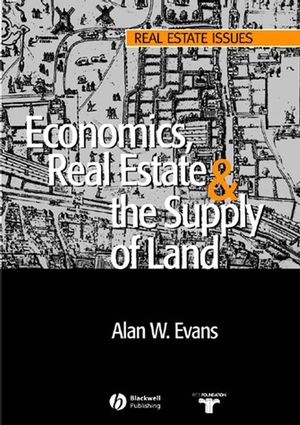Economics, Real Estate and the Supply of LandISBN: 978-1-4051-1862-0
Paperback
276 pages
August 2004, Wiley-Blackwell
 This is a Print-on-Demand title. It will be printed specifically to fill your order. Please allow an additional 10-15 days delivery time. The book is not returnable.
|
||||||
The supply of land.
The demand for land.
The development of a theory of the supply of land.
Chapter 2: Land Values, Rents and Demand.
Introduction.
Ricardian rent theory.
Neoclassical rent theory.
Ricardian theory remembered.
Planning controls and rent theory.
Hierarchical planning systems.
Urban rent theory.
Rents, economic and commercial.
Summary and conclusion.
Chapter 3: Coping with Changes in Demand.
Introduction.
The extensive margins.
The intensive margin.
Capital longevity and the asymmetry of change.
The process of change in the housing market.
Summary and conclusions.
Chapter 4: How Efficient is the Property Market?.
Introduction.
The economic concept of efficiency.
Efficient markets.
The evidence.
Tests of market efficiency.
Conclusions.
Chapter 5: Market Inefficiency: Causes and Consequences.
Introduction.
Why the property market is imperfect and inefficient.
Price determination and the theory of the core.
The consequences.
Conclusions.
Chapter 6: The Supply of Land for a Particular Use: Speculation and Uncertainty.
Introduction.
Speculation.
Uncertainty.
Summary and conclusion.
Chapter 7: The Supply of Land for a Particular Use: Occupier Performances and Residential Attachment.
Introduction.
Owner occupier attachment.
Some empirical evidence.
Summary and conclusions.
Chapter 8: The Ownership of Land.
Introduction.
Tenants, owner occupiers, and the supply of land.
Ownership and change.
Summary and conclusions.
Chapter 9: Land Ownership, Politics and Society.
Introduction.
Society and the ownership of land.
Alternative forms of ownership and tenancy.
A libertarian view.
Summary.
Chapter 10: Ownership and Control: Monopoly.
Introduction.
Monopoly rents and wine production.
Monopoly rents and shopping centres.
Summary and conclusions.
Chapter 11: Ownership and Control: Minimum Rents.
Introduction.
Minimum rents.
Minimum rents in an urban environment.
Summary and conclusions.
Chapter 12: Information, Uncertainty and the Property Market.
Introduction.
Modelling the search for information.
Searching for housing in practice.
The housing market.
The developer and land supply restriction.
Summary and conclusions.
Chapter 13: Land Availability and Land Banking.
Introduction.
Land availability.
Land banking by private firms.
Public land banking.
Summary and conclusions.
Chapter 14: Contiguity: Site Assembly.
Introduction.
A game theory approach.
A question of time.
Conclusion.
Chapter 15: Contiguity: Compulsory Purchase and the Scale of Development.
Introduction.
Compulsory purchase and the speed of acquisition.
Scale economies, acquisition costs, and history.
Summary and conclusion.
Chapter 16: Contiguity: Land Reallocation and the Price of Land.
Introduction.
Land reallocation or adjustment.
Size of site and the price of land.
Summary and conclusions.
Chapter 17: The Taxation of Land and Development Gains.
Introduction.
The undeserving landowner.
Betterment.
Economic theory and taxes on development.
Land taxation in recent British history.
Summary and conclusions.
Chapter 18: Annual Taxation and the Nationalisation of Land.
Introduction.
Property taxes and the rates.
Site value taxation.
Land nationalisation.
Summary and conclusions.
Chapter 19: Themes and Changes in Perception.
Recapitulation.
Coda



